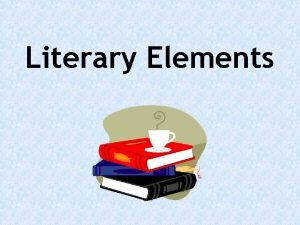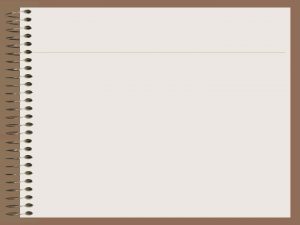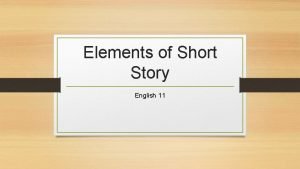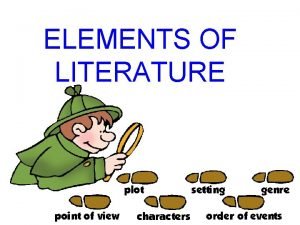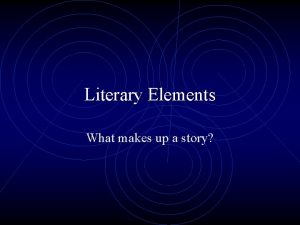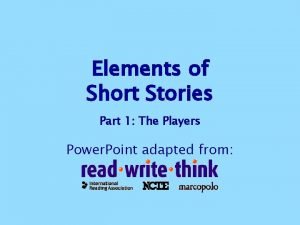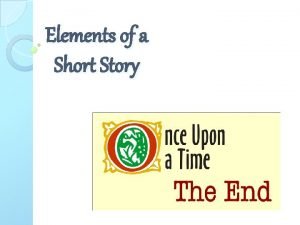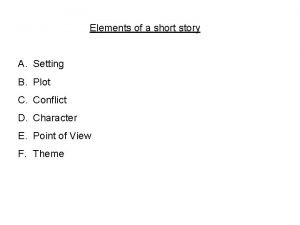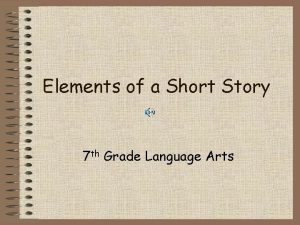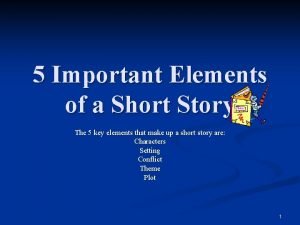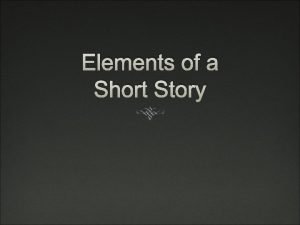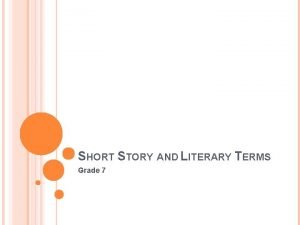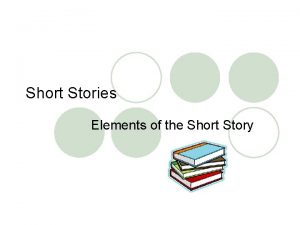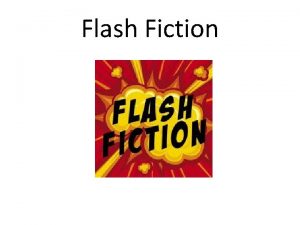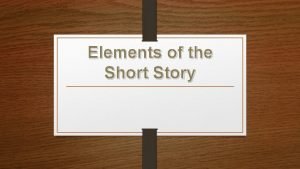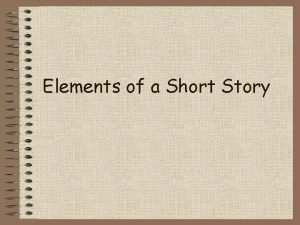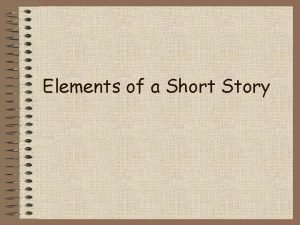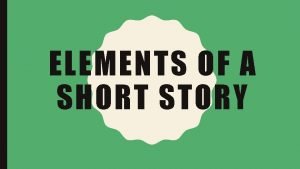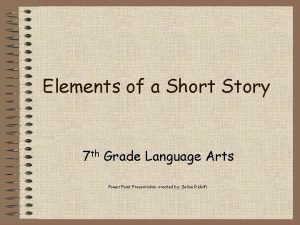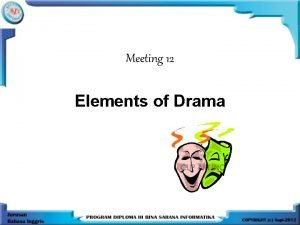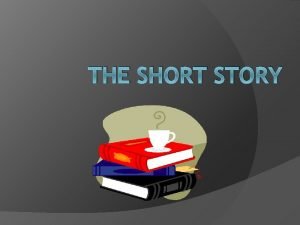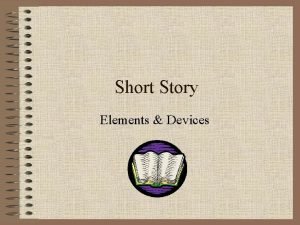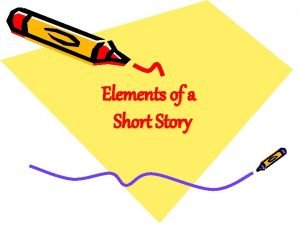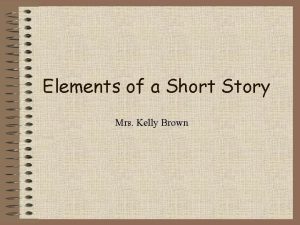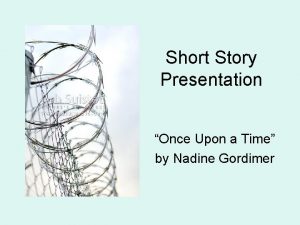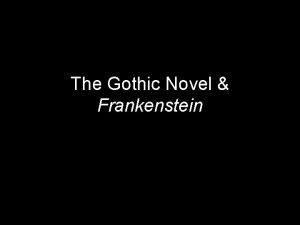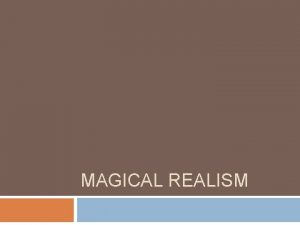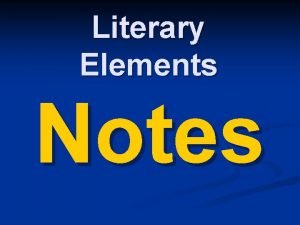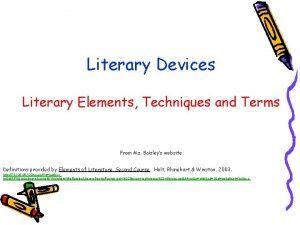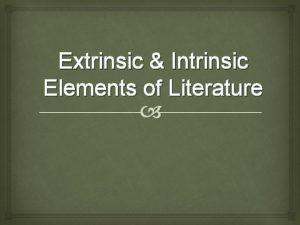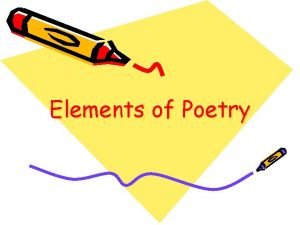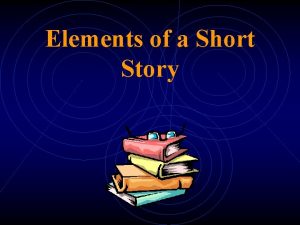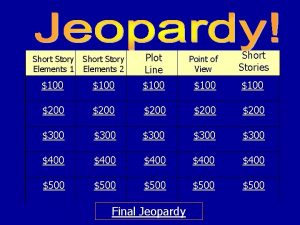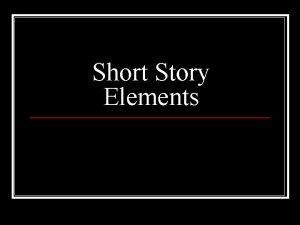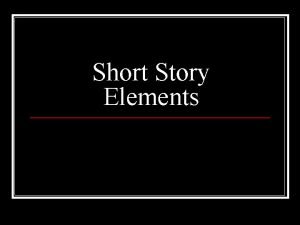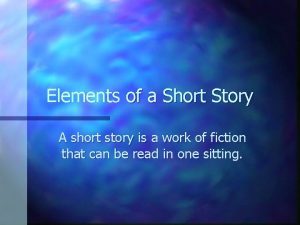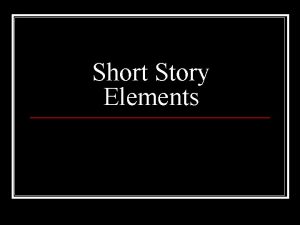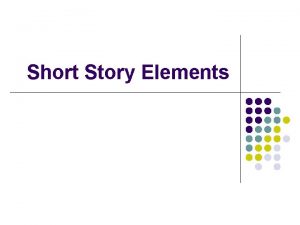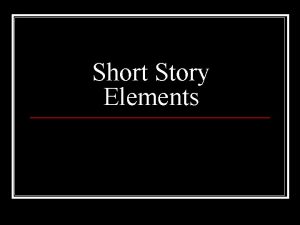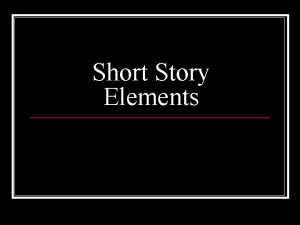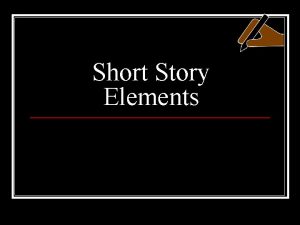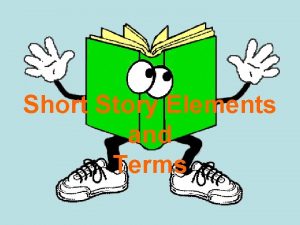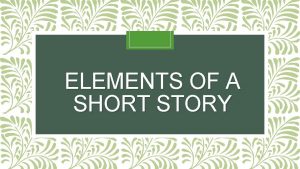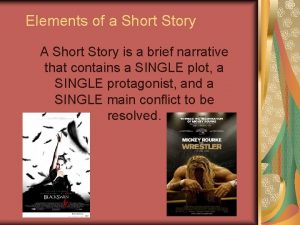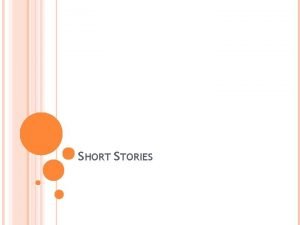ELEMENTS OF LITERATURE 1 Short Story A short




































- Slides: 36

ELEMENTS OF LITERATURE

1) Short Story A short form of fiction with characters, a setting, and a plot. It presents a sequence of events, or plot. It resembles longer forms of fiction because it provides the reader with a theme or lesson.

2) Plot is the pattern of events in a story. Plot development usually consists of these elements: 1. Exposition 2. conflict (rising action) 3. Climax 4. falling action 5. resolution. 3 4 2 1 5

The beginning of the story. This is where the reader meets and learns about the main character and setting.

This is when most of the events take place. The character and conflict is developed. The rising action eventually leads to the climax.

This the turning point in the story. It is the high point of the action of the plot. It is the moment of greatest tension. The outcome of the plot depends on the climax.

The story begins to “wrap up” as the mysteries are explained and the characters return to their own lives.

This is the end of the story. The conflict of the story has been resolved in some way.


Putting It All Together 1. Exposition 2. Rising Action 3. Climax 4. Falling Action 5. Resolution Beginning of Story Middle of Story End of Story

http: //www. youtube. com/watch? v=ff. AOk. Gg 2 Lr 4

9) Character? A character is a person, animal, or object that takes part in the action of a literary work. Types of characters: 1. Protagonist 2. Antagonist 3. Main Character 4. Minor Character

10)Protagonist The Protagonist is the main character, the hero. (The good guy) Look at the ROOT ‘Pro’ means for The protagonist is generally who the audience roots for

11) Antagonist The Antagonist is the character or force that works against the protagonist. The antagonist can be viewed as the “bad guy”, villian or the source of conflict. Look at the ROOT ‘Anti’ means against The antagonist is against the reaching their goal protagonist

12) Main Character The Main Character is the most important character in the story, poem, or play. Example… Harry Potter, Ron Weasly and Hermione Granger are the MAIN CHARACTERS in the story Harry Potter. These characters are all important to the plot of the story The story could not be told with out these characters.

13) Minor character The Minor Character is the one who takes part in the action, but is not the focus of attention Example… The stepsisters in the story Cinderella These characters take part in the story but NOT the main focus. The story can still go they are on with out them.

On your paper take a few moments to write down a list of Protagonists, Antagonists, Main character and Minor Character that you can recall from movies, television shows, and video games. Protagonist Antagonist Main Minor Character

15) Setting

The setting tells the reader where and when a story takes place. What is the time period? Era (ex: Great Depression) Time Period What time Of day is it? Morning Afternoon Night What is the Weather like? Hot Rainy Cold Where is the Location? City Neighborhood State Region

Why is the setting important? The Setting Effects The beliefs and actions of characters For example: A story that takes place in the South during the Civil War would be different than a story that take in New York during the civil war. The Setting Effects Feeling or Mood For example: A story set in the dark woods at night will probably have a scary, eerie feeling.

16) Conflict

What are the different types of Conflict? Man vs. Nature Man vs Society Man vs Self occurs when one person struggles against another person. occurs when a person struggles against the forces of nature (ex: storm, disease, starvation, wild animals) occurs when a character struggles against the rules, laws, or customs that surround him (ex: a victim of racism, a social outcast, or criminal. occurs when a character struggles with his own fears, ignorance, or conscience.

l occurs when one person struggles against another person.

Man vs. Nature l occurs when a person struggles against the forces of nature (ex: storm, disease, starvation, wild animals) Man vs. Nature

l occurs when a character struggles against the rules, laws, or customs that surround him (ex: a victim of racism, a social outcast, or criminal)

Man vs. Self l occurs when a character struggles with his own fears, ignorance, or conscience.

What is Point of View? • Point of view determines who is telling the story. It is the perspective the author chooses to tell the story • There are three types of point of view: 1. 2. 3. First person Third person limited Third person omniscient.

l Definition: The story is told by one of the characters. The narrator uses the word “I” to refer to that character. The events in the story are interpreted by this character. l Example: As I placed a carefully wrapped package on the park bench, I looked up and saw Molly walking across the street. I hoped that she hadn’t seen me.

Third Person Limited l Definition: Someone outside the story tells the story. The reader know the thoughts and feelings of only one or two characters l Example: As George placed the carefully wrapped package on the park bench, he looked up and saw Molly walking across the street.

Third Person Omniscient l Definition: The narrator provides the thoughts and feelings of many different characters. The reader can “get inside the head” of all the main characters. l Example: George anxiously hoping that no one was watching him, placed a carefully wrapped package on an empty park bench. But Molly, who was walking home, saw him and couldn’t help thinking that he was acting strangely.

What is Foreshadowing? • Foreshadowing is when the author gives clues or hints about what might happen later on in a story. • • Writers use foreshadowing to build their readers’ expectations and to create suspense. Example: Nothing could go wrong on such a perfect day. Or so I, in my childlike innocence thought. • Example: When you hear scary music in a movie, something scary is probably going to happen.

What is Theme? Theme is the central message, concern, or purpose of a story. It is the lesson of the story. A theme can usually be expressed as a general statement about human beings or about life. 2 Types General Themes The “big ideas” in a piece of literature. Example: love, friendship, or good vs. evil. Specific Themes The message the author is trying to communicate to the reader. Example: Beauty is in the eye of the beholder. Example: Love conquers all. Example: Money can’t buy happiness.

What is Tone? • Tone is the feeling that the story gives to the reader. • Some words that are used to describe tone are: light spooky Example: Tale Tell Heart http: //www. youtube. com/wa tch? v=t 8 So 5 Zy. Ft. WU dark mysterious scary joyful

What are three types of literarture? 1. Short Story 2. Novel 3. Poetry

What is a Novel? • A long work of fiction. • It has a plot or a sequence of events that explores the characters facing a problem in specific time and place. • May introduce subplots or minor stories within a larger one. • May have several themes.

What is Poetry? Each word has meaning Poetry uses: � Imagery � Figurative language - simile, metaphor, personification � Sound Devices Such as rhyme.
 Short short short long long long short short short
Short short short long long long short short short Element of the story example
Element of the story example Introduction of the story
Introduction of the story Define setting in literature
Define setting in literature Five elements of story writing
Five elements of story writing Short story with setting character plot conflict and theme
Short story with setting character plot conflict and theme Short paragraph to entertain
Short paragraph to entertain Elements of a short story video
Elements of a short story video Elements of a short story powerpoint
Elements of a short story powerpoint Objectives for elements of the story
Objectives for elements of the story Setting
Setting Elements of a short story grade 7
Elements of a short story grade 7 5 element of a short story
5 element of a short story Identify the elements of short story. *
Identify the elements of short story. * Exposition story examples
Exposition story examples Parts of a short story
Parts of a short story Flash fiction
Flash fiction Numbered plot diagram
Numbered plot diagram Short story elements definitions
Short story elements definitions Elements of a story definition
Elements of a story definition Moral of the story definition
Moral of the story definition Elements of a short story grade 7
Elements of a short story grade 7 What are the drama elements
What are the drama elements Cinderella protagonist and antagonist
Cinderella protagonist and antagonist Short story with complete elements
Short story with complete elements Plot diagram of cinderella story
Plot diagram of cinderella story Short story elements
Short story elements Elements of the short story
Elements of the short story Once upon a time story beginnings
Once upon a time story beginnings How is frankenstein a gothic novel
How is frankenstein a gothic novel Is magical realism a genre
Is magical realism a genre Elements of literature definition
Elements of literature definition Literary elements of literature
Literary elements of literature Intrinsic elements meaning
Intrinsic elements meaning Elements of tragedy in literature
Elements of tragedy in literature Elements for poetry
Elements for poetry Imagery definition literature
Imagery definition literature

